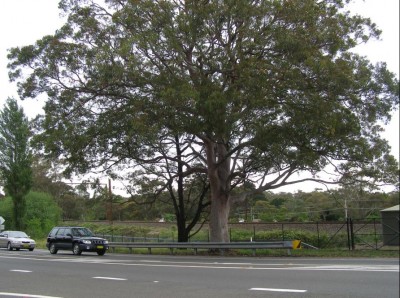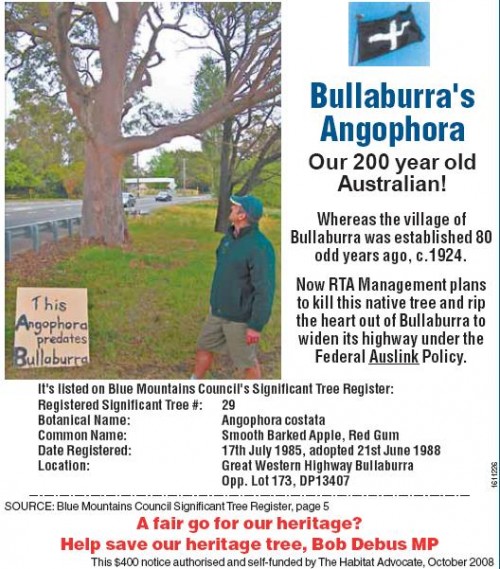by Editor 20101010.
Rogue leaf
Believe it or not
I hung on all winter
outfacing wind and snow
.
Now that spring
comes and the birds sing
I am letting go.
-by Northern Irish poet Derek Mahon
.
Across Prehistoric Britain’s wild dense temperate forests, its moors and boglands – wildlife once teamed.
Agrarian Man, followed by the excesses of Industrial Man, wiped out much of this wildlife and decimated its natural habitat – reducing the landscape to paddocks within a network of pastoral hedgerows and leaving a few tokenistic islands of natural reserves to the ruling classes .
But now it seems that even the hedgerows across the British Isles are at risk from Corporate Man’s insatiable quench for land and profit.
Government leaders could rule to defend the remnants of the British Isles’ natural heritage, yet choose not to.
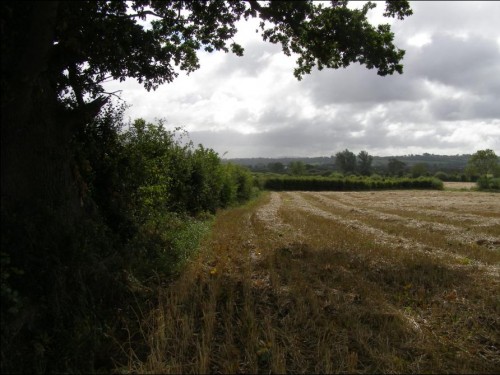 Hedgerows and a hedgerow tree (oak). County Amagh, Northern Ireland.
[Photo and those below taken by the editor 20100916, free on Public Domain – click to enlarge.]
Hedgerows and a hedgerow tree (oak). County Amagh, Northern Ireland.
[Photo and those below taken by the editor 20100916, free on Public Domain – click to enlarge.]
.
What is a Hedgerow?
“A hedgerow is a line of closely spaced shrubs and tree species, planted and trained in such a way as to form a barrier or to mark the boundary of a field and used to separate a road from adjoining fields or one field from another.
A hedgerow may consist of a single species or several, typically mixed at random. In most newly planted British hedgerows, at least 60 percent of the shrubs are hawthorn, blackthorn, and (in the southwest) hazel, alone or in combination. The first two are particularly effective barriers to livestock. Other shrubs and trees used include holly, beech, oak, ash, and willow; the last three can become very tall.
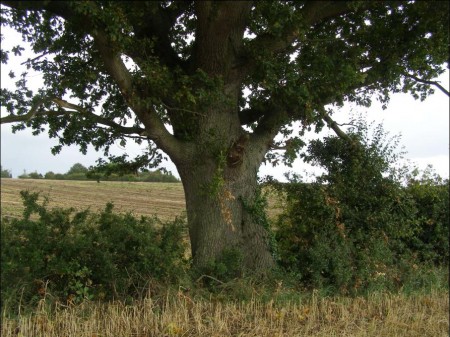 Across the British Isles many hedgerows include fully grown trees (‘hedgerow trees’), typically those mentioned above. There are thought to be around 1.8 million hedgerow trees in Britain (counting only those whose canopies do not touch others) with perhaps 98% of these being in England and Wales. Hedgerow trees are both an important part of the English landscape and are valuable habitats for wildlife. Many hedgerow trees are veteran trees and therefore of great wildlife interest.
Across the British Isles many hedgerows include fully grown trees (‘hedgerow trees’), typically those mentioned above. There are thought to be around 1.8 million hedgerow trees in Britain (counting only those whose canopies do not touch others) with perhaps 98% of these being in England and Wales. Hedgerow trees are both an important part of the English landscape and are valuable habitats for wildlife. Many hedgerow trees are veteran trees and therefore of great wildlife interest.
The most common species are oak and ash, though in the past elm would also have been common. Around 20 million elm trees, most of them hedgerow trees, were felled or died through Dutch elm disease in the late 1960s. Many other species are used, notably including beech and various nut and fruit trees. The age structure of British hedgerow trees is old because the number of new trees is not sufficient to replace the number of trees that are lost through age or disease.”
[Source:
http://en.wikipedia.org/wiki/Hedge_(barrier)]
“Hedgerows serve as important wildlife corridors, especially in the United Kingdom where they link the country’s fractured ancient woodland. They also serve as a habitat for birds and other animals. As the land within a few metres of hedges is difficult to plough, sow, or spray with herbicides, the land around hedges also typically includes high plant biodiversity. Hedges also serve to stabilise the soil and on slopes help prevent soil creep and leaching of minerals and plant nutrients. Removal thus weakens the soil and leads to erosion. “
[Source:
http://en.wikipedia.org/wiki/Hedgerow_removal]
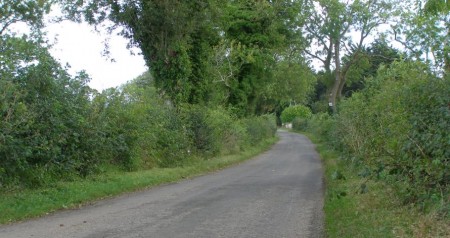
What is Hedgerow Removal?
“Hedgerow removal is part of the transition of arable land from low-intensity to high-intensity farming. The removal of hedgerows gives larger fields making the sowing and harvesting of crops easier, faster and cheaper, and giving a larger area to grow the crops, increasing yield and profits.
In the United Kingdom hedgerow removal has been occurring since World War I as technology made intensive farming possible, and the increasing population demanded more food from the land. The trend has slowed down somewhat since the 1980s when cheap food imports reduced the demand on British farmland, and as the European Union Common Agricultural Policy made environmental projects financially viable. Under reforms to national and EU agricultural policies the environmental impact of farming features more highly and in many places hedgerow conservation and replanting is taking place.
In England and Wales agricultural hedgerow removal is controlled by the Hedgerows Regulations 1997, administered by the local authority.” – 7.—(1) A person who intentionally or recklessly removes, or causes or permits another person to remove, a hedgerow in contravention of regulation 5(1) or (9) is guilty of an offence.’
[Source:
http://en.wikipedia.org/wiki/Hedgerow_removal]
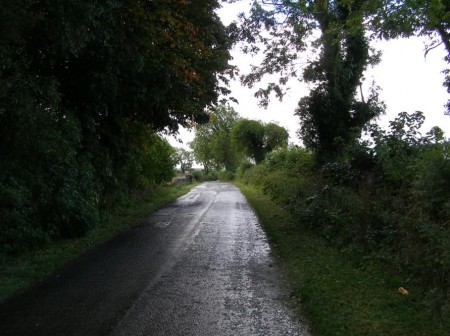
Hedgerow Removal is a serious threat to the biodiversity of wildlife across the British Isles
The hedgerow, “a ubiquitous staple of the British countryside, is actually a species under threat and between 1940 and 1990, the common hedgerow underwent a dramatic decline; predominantly due to human influence. More worryingly, the cornucopia of British wildlife that used to thrive in these hedgerows is suffering from the decrease in natural habitat. A combination of increased urbanisation, a rise in the intensity of farming and therefore field size, overgrazing by livestock and improper maintenance have all had a detrimental effect on our hedgerows.
Another key human factor is the collective ignorance of the 1997 Hedgerow Regulations that demand the application for a removal notice for any hedgerow exceeding thirty years of age. There are hedgerows in the UK that date back from before the Enclosure Acts period – 1720 – 1840 and it is a dreadful thought that this precious rural heritage is potentially being destroyed.”
[Source:
Josh Ellison of Floral & Hardy]
“Between 1984 and 1993 185,000km of hedgerow in England and Wales was lost.
This decline was not simply important in a British context but also in a European context. This is because hedged landscapes are found in relatively few areas: parts of northern France; northern Italy; the Austrian Alps and the Republic are Ireland.”
[Source: Naturenet website – ‘
Hedgerow Protection in England and Wales’ by Alina Congreve. ^
http://www.naturenet.net/articles/congreve/index.html]
.
[The following article by Emily Dugan appeared in the British Sunday newspaper, The Independent, on Sunday 29th August 2010.
Source: http://www.independent.co.uk/environment/nature/are-we-losing-the-fight-to-save-our-hedgerows-2064800.html]
Are we losing the fight to save our hedgerows?
“A decade after the first legal moves to protect them, they are still under attack – and now they could fall victim to spending cuts
They are the living seams that have typified the British countryside for centuries. But now hedgerows are disappearing fast, and a report published tomorrow will say we are not doing enough to protect them.
Research from the Campaign to Protect Rural England has found that though hedgerows enjoy more protection than ever before, in England their overall length fell by 26,000 kilometres between 1998 and 2007. The study, England’s Hedgerows: Don’t Cut Them Out!, calls for current legislation to be strengthened.
As well as having a nostalgic place in the aesthetics of the countryside, hedgerows are a vital part of the ecosystem. Research by Hedgelink, a network of British hedge conservation groups, shows that without them some 130 species – from the hedgehog and the dormouse to stag beetles and the cuckoo – would be under threat.
Although “important” hedgerows are protected by law, the majority can be taken down if a landowner wishes, which has resulted in many being dug up to create larger fields that are easier to harvest. For the past 20 years, the Government has provided financial help to landowners to restore and manage hedgerows. But most have still been left unmanaged, sometimes growing into larger trees offering fewer benefits to wildlife because they are less dense at ground level.
The CPRE study focused on England, but the picture nationwide is similarly grim.
Nigel Adams, vice-chairman of the National Hedgelaying Society, said: “The hedgerow is the unsung hero of our countryside. It’s often overlooked, but visitors to England say it’s what makes it so special. The majority are not used for their original purpose [as an animal barrier], but people recognise their importance in terms of wildlife and history.”
Since 1998, the number of legally protected hedgerows has risen by 18 per cent. Currently, 42 per cent of the UK’s hedgerows are protected, but the CPRE fears that the narrow criteria required to register a stretch of hedge as “important” will mean many more are lost.
To qualify for legal protection, a hedge must be at least 20 metres long, 30 years old and meet strict criteria on heritage and numbers of animals and plants relying on it. Some hedges were easy to register, such as Judith’s Head in Cambridgeshire, which is Britain’s oldest, having stood for more than 900 years. But for non-celebrity hedges, the future is dicey. More than two-thirds of local authorities surveyed by CPRE said that the current Hedgerow Regulations needed to be simplified to make them more effective.
Emma Marrington, author of the report, said: “The length of hedgerows in the country is declining, which is worrying. They’re a part of our heritage, but they also offer huge benefits to wildlife and the environment in general. It’s over a decade since the introduction of the Hedgerows Regulations, and the time is ripe for the Government to make improvements that give local authorities the power they need to better protect the great diversity of England’s hedgerows.”
The CPRE is concerned that hedgerow protection programmes could be at risk when the Department for Environment, Food and Rural Affairs (Defra) makes spending cuts in the autumn. “The Defra spending cuts could affect the money for schemes like this,” Ms Marrington said. “I can see how hedgerows could be overlooked; they’re taken for granted as being a part of the English countryside, and people don’t realise how much they’re at risk.”
If hedgerows in Britain decline further, so too will those species that depend on them. Jim Jones of the People’s Trust for Endangered Species is running a study of the impact of disappearing hedgerows on dormice, a species whose population has declined by 40 per cent in 20 years. “Dormice have disappeared from seven counties where they existed in the 1800s, at the same time as hedgerows have declined,” he said. “Hedgerow corridors are crucial because they allow them to forage and move around.”
Species in peril: An ecosystem teeming with life
Mammals
Dormice, harvest mice, hedgehogs, six species of bat, and polecats are all at risk as hedgerows decline. They rely on the covered corridors that allow them to move around.
Plants
The copse bindweed and the Plymouth pear are among the plants that flourish in hedgerows.
Fungi and lichens
From the sandy stilt puffball to the weather earthstar fungus, many fungi do particularly well in hedgerows. Lichens such as the orange-fruited elm lichen and the beard lichen are also at risk.
Invertebrates
Stag beetles, brown-banded carder bees and large garden bumblebees are among those at risk. More than 20 of Britain’s lowland butterfly species breed in hedgerows, including the brown hairstreak and the white-letter hairstreak butterfly.
Reptiles and amphibians
Hedgerows connecting with ponds are vital for great crested newts to move through the countryside. The common toad, grass snake, slow worm and common lizard are also at risk.
Birds
Many woodland birds rely on taller hedges for breeding. The turtle dove, grey partridge, cuckoo, lesser spotted woodpecker, song thrush, red-backed shrike and yellowhammer are all in danger.”
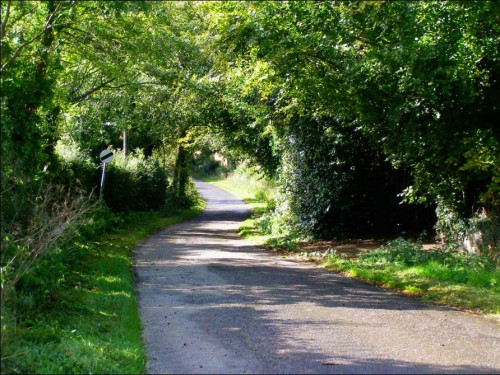
Further Reading:
.
[1]
Naturenet website ‘Hedgerow Protection in England and Wales’ by Alina Congreve. ^
http://www.naturenet.net/articles/congreve/index.html]
[2]
Hedgelink website homepage –
‘the first place to look for information on the UK’s native hedges, hedgerow conservation and hedge management.’ http://hedgelink.org.uk/
[3]
Hedgelink website – ‘
Hedgerow Biodiversity Action Plan‘
http://www.hedgelink.org.uk/index.php?id=29
[4]
Hedgelink website –
‘Hedgerow management’ http://www.hedgelink.org.uk/index.php?id=30
[5]
Hedgerowmobile website –
‘Hedgerows, Hedges and Verges of Britain and Ireland, exploring the legal and environmental aspects of British and Irish hedgerow and verge ecology, ecotones as well as management strategies.’ http://hedgerowmobile.com/
[6]
UK Legislation.gov.uk – ‘
the official home of enacted revised UK legislation.‘
http://www.legislation.gov.uk/uksi/1997/1160/contents/made
[7]
University of Reading (England) – ‘
Environmental Challenges in Farm Management [ECIFM] – changes in habitat’ http://www.ecifm.reading.ac.uk/habitat.htm
[8]
Epping Forest District Council (England) – ‘
Prosecution for the Unauthorised Removal of Hedgerows’ (8th September 2010),
http://www.eppingforestdc.gov.uk/news/2010/prosecution_unauthorised_removal_hedgerows.asp
[9]
Norfolk Biodiversity Partnership (England) –
‘Habitat Action Plans – Hedgerows’ http://www.norfolkbiodiversity.org/actionplans/habitat/hedgerows.asp
[10]
South Straffordshire Council (England) –
‘Hedgerows (Field and Countryside)’ http://www.sstaffs.gov.uk/your_services/architectural__landscape_serv/hedgerows_field_and_countrysi.aspx
[11]
The Sunday Times (UK) – article by Richard Girling July 12, 2009: ‘
Britain’s wildlife: Work on the wild side’ – to save our wildlife we must get our priorities right. How far should we meddle with the animal kingdom?’ http://www.timesonline.co.uk/tol/news/environment/article6685127.ece
[12]
The Telegraph (UK) – article by Charlie Brooks 16
th July 2009: ‘
Bird-brains who undermine our farmers‘ – when it comes to conservation, landowners can be trusted to make the right decisions. ‘The European Union Habitats Directive has claimed that some 90 per cent of the UK’s threatened habitats are “in poor shape and therefore not supporting the range of wildlife they should do.”
http://www.telegraph.co.uk/comment/personal-view/5843663/Bird-brains-who-undermine-our-farmers.html
[13]
Countryside Jobs Service (North Yorkshire, England) –
Countryside Jobs Service in association with The Tree Council For National Tree Week launched its Hedge Tree Campaign on 23 November 2009. http://www.countryside-jobs.com/Focus/Previous/Nov09.htm
[14]
Wikipedia http://en.wikipedia.org/wiki/Hedgerow_removal
.
– end of article –
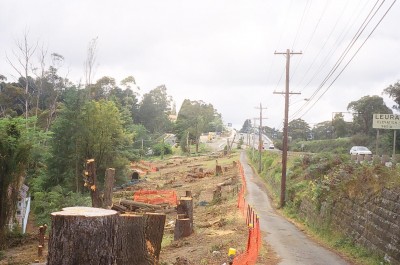 Great Western Highway at nearby Leura, 20th December 2006
Photo by Ivan Jeray.
Great Western Highway at nearby Leura, 20th December 2006
Photo by Ivan Jeray.
